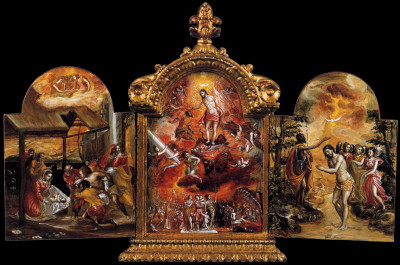The Modena Triptych, or Triptico de Modena, was completed by El Greco in 1568. The original work can be found today in the Galleria Estense in Modena, Italy.
In line with the standard format of a triptych, the artist would produce paintings for both sides of the panels. This ensured that something would always be shown, whether the altarpiece wings were open or closed. Whilst this doubled the work necessary for the artist, it meant the altarpiece could be used in many different positions, and did not necessarily have to be placed against a wall. In most cases, any triptych from this period would place the main content down the centre, with the side panels then offering further content to support the main panel. Additionally, the reverse would continue along roughly the same theme so that there was a consistency across the whole project. It was rare for El Greco to produce a triptych, though at this early stage of his career he was looking to appease as many patrons as possible. In later years he continued creating series of artworks for religious institutions, but normally as separate canvases which would be dispersed around the same room or building. The themes covered within this design were the Adoration of the Shepherds, the Allegory of a Christian Knight, and the Baptism; and on the back, the Annunciation, Mount Sinai, and Adam and Eve.
The triptych is relatively small, measuring 37cm tall for the central panels, with the side panels being slightly shorter because they did not have the same depth of frame around their perimeter. Interestingly, many elements of the content have a connection to Crete, which is where the artist was originally from. Relatively little is known about his time here as compared to when his reputation soared later on, and so any connection to his early life is highly valuable to historians. We do know that the artist was particularly religious and so to see content such as this is hardly surprising. As his career took off he would start to receive requests for portraits from local people in each place that he lived, and so naturally the balance of his career would start to change. He never turned his back on religious content, though, and also produced many portraits of cardinals and other religious figures in Italy and Spain.
The Triptych of Modena is one of the earliest examples that we have from El Greco's career. He may have just arrived in Italy at this point, giving us an insight into the impact made upon him by Crete. Later, the Italian masters who he studied in detail would change his direction. He relied on Byzantine art for inspiration initially, and the content of these painting panels links directly to that. Some of the themes found here would be re-visited in later works, but with more expression and a unique flavour which marked the artist's evolution over time. Those studying his early period in Crete should refer to the style of this triptych, with six different artworks found together in one truly stunning display.




